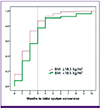3. Park WS, Kang HY, Kim SJ, Cha JO, Son HJ, Park O. Notified tuberculosis status in Korea, 2015. Public Health Weekly Report of the KCDC. 2015; 9:342–345.
4. Kwon YS, Kim YH, Suh GY, Chung MP, Kim H, Kwon OJ, Choi YS, Kim K, Kim J, Shim YM, Koh WJ. Treatment outcomes for HIV-uninfected patients with multidrug-resistant and extensively drug-resistant tuberculosis. Clin Infect Dis. 2008; 47:496–502.

6. Jensen PA, Lambert LA, Iademarco MF, Ridzon R. CDC. Guidelines for preventing the transmission of Mycobacterium tuberculosis in health-care setting, 2005. MMWR Recomm Rep. 2005; 54:1–141.
7. Long R, Bochar K, Chomyc S, Talbot J, Barrie J, Kunimoto D, Tilley P. Relative versus absolute noncontagiousness of respiratory tuberculosis on treatment. Infect Control Hosp Epidemiol. 2003; 24:831–838.

8. Scrimshaw NS. Historical concepts of interactions, synergism, and antagonism between nutrition and infection. J Nutr. 2003; 133:316S–21S.

9. Zachariah R, Spielmann MP, Harries AD, Salanioni FM. Moderate to severe malnutrition associated with early death in patients with tuberculosis is a risk factor. Trans R Soc Trop Med Hyg. 2002; 96:291–294.

10. Podewils LJ, Holtz T, Riekstina V, Skripconoka V, Zarovska E, Kirvelaite G, Kreigere E, Leimane V. Impact of malnutrition on clinical presentation, clinical course, and mortality in MDR-TB patients. Epidemiol Infect. 2011; 139:113–120.

11. Canetti G, Fox W, Khomenko A, Mahler HT, Menon NK, Mitchison DA, Rist N, Smelev NA. Advances in techniques of testing mycobacterial drug sensitivity, and the used of sensitivity tests in tuberculosis control programmes. Bull World Health Organ. 1969; 41:21–43.
12. Holtz TH, Sternberg M, Kammerer S, Laserson KF, Riekstina V, Zarovska E, Skripconoka V, Wells CD, Leimane V. Time to sputum culture conversion in multidrug-resistant tuberculosis: predictors and relationship to treatment outcome. Ann Intern Med. 2006; 144:650–659.

13. Hafkin J, Modongo C, Newcomb C, Lowenthal E, MacGregor RR, Steenhoff AP, Freidman H, Bisson GP. Impact of the human immunodeficiency virus on early multidrug-resistant tuberculosis treatment outcomes in Botswana. Int J Tuberc Lung Dis. 2013; 17:348–353.

14. Qazi F, Khan U, Khowaja S, Javaid M, Ahmed A, Salahuddin N, Hussain H, Becerra MC, Golub JE, Khan AJ. Predictors of delayed culture conversion in patients treated for multidrug-resistant tuberculosis in Pakistan. Int J Tuberc Lung Dis. 2011; 15:1556–1559.

15. Hickson M. Malnutrition and ageing. Postgrad Med J. 2006; 82:2–8.

16. Harris T, Cook EF, Garrision R, Higgins M, Kannel W, Goldman L. Body mass index and mortality among nonsmoking older persons. The Framingham heart study. JAMA. 1988; 259:1520–1524.

17. Lee YM, Kim SM, Park SJ, Lee SO, Choi SH, Kim YS, Woo JH, Kim SH. Factors associated with a strong response to the T-SPOT.
TB in patients with extrapulmonary tuberculosis. Infect Chemother. 2014; 46:248–252.

18. Scrimshaw NS, SanGiovanni JP. Synergism of nutrition, infection, and immunity: an overview. Am J Clin Nutr. 1997; 66:464S–477S.

19. Mupere E, Malone L, Zalwango S, Chiunda A, Okwera A, Parraga I, Stein CM, Tisch DJ, Muqerwa R, Boom WH, Mayanja H, Whalen CC. Lean tissue mass wasting is associated with increased risk of mortality among women with pulmonary tuberculosis in urban Uganda. Ann Epidemiol. 2013; 22:466–473.

20. Kurbatova EV, Gammino VM, Bayona J, Becerra MC, Danilovitz M, Falzon D, Gelmanova I, Keshavjee S, Leimane V, Mitnick CD, Quelapio MI, Riekstina V, Taylor A, Viklepp P, Ziqnol M, Ceqielski JP. Predictors of sputum culture conversion among patients treated for multi-drug-resistant tuberculosis. Int J Tuberc Lung Dis. 2012; 16:1335–1343.









 PDF
PDF ePub
ePub Citation
Citation Print
Print




 XML Download
XML Download